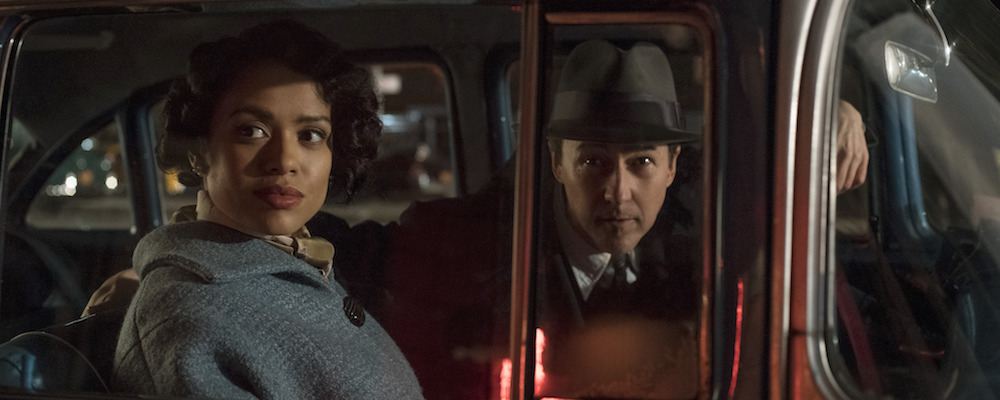Edward Norton’s ‘Motherless Brooklyn’ Transplants the Contemporary Crime Novel to the 1950s With Mixed Results
Andrew Bundy
“If I were a Dick Tracy villain, I’d have to be Mumbles,” gumshoe Lionel Essrog suggests in his rambling opening monologue from Jonathan Lethem’s best-selling crime novel, “Motherless Brooklyn.” In the book he’s described as a self-appointed human freakshow, whereas in the film version, writer/director/star Edward Norton plays Lionel as if his character is initially embarrassed by the nickname bestowed on him by the city.
The film transplants Lethem’s ‘90s narrative to the 1950s, a time before Dick Tracy was the tropey noir-strip classic it is today. Lionel Essrog is a snoop who struggles with coprolalia, a condition of the nervous system that results in repeated, involuntary twitches and outbursts — sometimes obscene ones. In Lethem’s novel, he is described as having Tourette’s syndrome, though his condition remains unnamed in the film, likely due to the historic transposition.
Norton’s “Motherless Brooklyn” opens with a stylish sequence. Lionel and his cohort Coney (Ethan Suplee) keep watch as point men for their mentor, Frank Minna (Bruce Willis) who runs the detective agency the boys work out of. Listening in on a secret phone line on a private meeting, Lionel, an orphan, suspects that his father figure is in danger. His instincts turn out accurate when Frank dies of a gunshot wound following a tense car chase, leaving Minna’s wife, Julia (Leslie Mann) stuck with a rundown group of lowlife snoops and some loan shark debt.
After one of his investigative co-workers (Dallas Roberts) takes a hard beating, being told to “Stay out of Minna’s garbage,” Lionel realizes that his mentor was caught up in something big, very big. Having a near perfect memory, he jots down all the names, statements, and words he didn’t understand from Minna’s mysterious meeting, piecing together all the puzzle pieces of what was said on the other side of that phone call.
The clues lead him to a gentrification conspiracy, involving Moses Randalph (Alec Baldwin), a high-strung engineering genius (Willem Dafoe), and a woman named Laura Rose (Gugu Mbatha-Raw), who’s uncle owns an overly protective jazz club with a local hardened trumpet player (Michael Kenneth Williams). To get too into the plotting details would get into spoiler specifics, but it’s fair to say the movie walks over much of the same territory as both “Chinatown,” and “Devil In A Blue Dress,” a pair of noir classics that Norton’s film can’t quite match, the period parallels also doing the film few favors.
Frankly, the movie has far too many characters and can’t fit them all into its dense narrative (only about half having been mentioned in this review). Roberts and Suplee are each underutilized after standing out in the opening act. The great Bobby Cannavale rounds out Lionel’s co-worker trio, but his role is sorely underdeveloped; a side plot involving his character interrupting the main narrative late in the game, adding little to the proceedings outside adulterous clichés.
Part of the problem is Norton tries to shove material from another book into his already overstuff adaption and the political parallels are way too on the nose. Baldwin’s character is a direct callback to “master builder” Robert Moses. Robert Caro’s biography on Moses, “The Power Broker,” also being a source of inspiration for Norton. This adds a level of Mulholland-esque detestable grand thievery to the urban renewal proceedings, but also some obvious Donald Trump references. Baldwin inhabits the tyrannical figure with the reckless swagger of a human wrecking ball, both with a walking hitch and chip on his shoulder, and his casting is forcibly on the nose, described as being the type willing to settle for eating pastrami sandwiches for the rest of his life so long as it means holding power over women.
That said, Norton does his best as both a filmmaker and an actor, turning in a warm and empathetic performance. His vocal twitches are hit and miss, but they lead to some genuinely funny beats, and also some awkward “I don’t think I’m supposed to be laughing at this,” type moments. The score is perhaps the film’s greatest strength. It’s deliberately overbearing, aiming to capture all the musical noise that swirls and swells around in Lionel’s head. The narration is translated to similarly mixed results; Lethem’s interior monologue from the source material are hit or miss, and how it’s used is very inconsistent. The film falters in its telling the audience how they should feel and what to think, rather than to rely on technique, which Norton certainly has.
What works best about this approach is how the audience enters Lionel’s POV. The film uses catching point of view shots to place the viewer inside the gumshoe’s headspace. Sometimes the music even stands in for this through process, an excellent formal idea, executed in a muddled manner. Some eye-catching transitions and interest time lapse dissolves reveal Norton’s confidence as a director. He also has outstanding chemistry with Gugu Mbatha-Raw, their scenes housing the most tender moments of the movie.
“An unfinished puzzle makes my head hurt more than most people,” Lionel says. “Motherless Brooklyn” doesn’t exactly feel unfinished, but it’s over-stretched noir by the numbers; it’s long and languorous, with a noticeable runtime. Adapting the material as a period crime movie works in part but was perhaps not the best decision for the source material; Lethem’s language stands on its own. Thankfully, an exceptional cast and some expressive directorial decisions — which don’t all work, but at least Norton is ambitious — add enough flavor to make the movie worth watching for fans of the detective yarn.
“Motherless Brooklyn” opens Nov. 1 in theaters nationwide.

